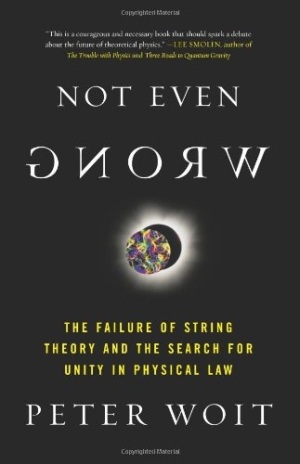STRING THEORY -- SO WRONG
IT'S NOT EVEN WRONG!
by Nick Schweitzer, guest contributor.
[December 1, 2006]
 [WeeklyUniverse.com]
This theory, which has excited many and dumbfounded even more, is known
as String Theory, Super String Theory, or M-Theory, depending on the version
you are studying. [WeeklyUniverse.com]
This theory, which has excited many and dumbfounded even more, is known
as String Theory, Super String Theory, or M-Theory, depending on the version
you are studying.
Not
Even Wrong attempts to make the unpopular case that string theory,
and its more recent derivatives, is failed science and should be abandoned
so that scarce resources can be devoted to other more promising theories.
The idea
that a theory can not only be wrong, but "isn't even wrong" was popularized
by the physicist Wolfgang
Pauli, to describe that an idea that isn't just wrong, it doesn't actually
make any predictions which are either verifiable, or falsifiable, and thus
provides nothing of value.
To some brave physicists who are willing
to espouse such views, string theory would seem to fall into this category.
This book
is definitely not for the faint of heart in terms of communicating complicated
math and physics. I had to read through the first half of the book twice
in order to get a decent understanding of the ideas being thrown out.
Much of this first half is a history lesson of theoretical particle physics,
but with some technical elements easy to get lost in. It describes
in some detail the major breakthroughs that occurred pre- and post-WWII
that culminated in the development of the Standard Model, and different
versions of quantum theory.
Sometimes
this history lesson is nothing more than a listing of important events,
without much context as to why it's important to the central theme of the
book. After finishing the entire text, it is now obvious that the
entire point of the first half of the book was to layout the case (a case
which many would say should need no explanation) that physics should be
based on experimentally proved facts, and not on hopes and grand ideas
that can't be proved.
This laundry list of experimental evidence
is left in stark contrast the lack of evidence that string theory has to
back it up.
The second
half of the book contains the major dissection of string theory. The central argument is that string theory it really isn't a theory at
all, but more a framework that many hope will one day lead to a theory. We find that string theory, and its later derivatives, don't actually posit
anything which is falsifiable. In what the author views as an act
of desperation, this fact is now considered to be an advantage, and could
(or already has) led to a detrimental shift in how physics is studied. The universe is now a "multiverse."
When attempting
to solve string theory equations, if one equation doesn't result in something
which agrees with experimentally proved fact, than it is said that this
must apply to another universe, and another version would surely work in
ours.
The only proof that is provided behind this idea is the anthropic
principle. This basically means that since we're here and alive,
there must be a version of the equations which work. However, so
many assumptions are made in the theory that this is more of a leap of
faith than science. And since any version could be true, string theory
loses all predictive power in our universe, and so one is left to wonder
what use it has.
While
the author is not afraid to go after the current direction of physics,
and point out what he thinks is wrong, he also shows much praise to those
who are espousing these wrong views. He goes to some length to explain
the new directions and discoveries that have been made in advanced mathematics
that have come as a direct result of investigating string theory.
Although he feels that string theory itself if a bust, much of the math
that has come about attempting to prove string theory could lead to new
discoveries in and of itself. This may be the saving grace that string
theory has in the annals of history.
The last
chapters attempt to explain why so many scientists refuse to accept that
string theory is a failed idea. The author provides some very interesting
insight into the current state of academic achievement, grant programs,
and peer pressure. Like the old gambler who constantly loses at the
poker tables, and is told that the tables in the city are rigged, many
physicists continue to examine string theory because they say "it's the
only game in town."
In essence,
because so many people have invested in it with their careers and their
pride, many are simply passing the buck, and waiting for someone else to
explore new waters. A few theories are trying to make their way into
the fold, and Woit briefly explains a few of them, but only about one chapter
is devoted to the subject.
What he does provide throughout the book
however, are the names of other well known books in each subject he discusses
for those who want even more in-depth knowledge than he is willing to provide
here.
In the
end, Not
Even Wrong gives an interesting counterpoint to several other books
that have made string theory accessible and popular in the public mind,
including Brian Greene's The
Elegant Universe. The first half of the book can be hard to understand,
but that doesn't detract from the overall theme of the book, though it
can make it a difficult read at times.
Copyright 2006 by Nick Schweitzer.

|
